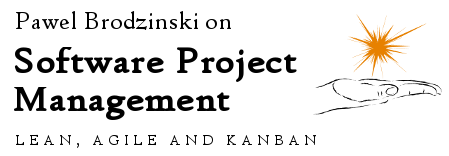If you are in broadly understood context of Agile you eventually has had to hear about being hyperproductive. Sources reporting a few hundred, or even as much as more than a thousand, percent productivity improvement aren’t unusual. In fact, 200% improvement seems to be “guaranteed” by some.
That’s great! Good for them! They’re going to get hyperproductivity badge or something. Yay!
What Hyperproductivity Is
Let’s start with the basics though. What is this whole thing? When a team becomes hyperproductive? How much do they have to improve? Oh, and by the way, if a super-crappy team improves three times and guys that were already great only by 20% would that mean that hyperproductivity was reached by the former, the latter, or both?
The most common metric I hear about in the context of hyperproductivity is velocity. Actually, I consider using velocity to measure productivity evil or dumb. How much should my team improve? By the factor of three? Nothing easier. Oh, and by the way, we don’t use our estimation poker card worth 1 that often anymore.
Note: I don’t deny teams improve. I merely point that stating so purely on a basis of velocity improvement is naive at best. There are so many potential dysfunctions of such approach that I don’t even know where to start. How the scope of work is split into individual tasks? What is a distribution of point estimates? How has it changed over time? What do we understand as a task in the first place? How do we account for rework?
In other words without understanding a specific context mentioning hyperproductivity is meaningless. Just a marketing fad, which it might have been in the first place.
Efficiency As a Goal
Even if we agreed on a reasonable proxy for measuring productivity there’s a bigger problem ahead. We are not in a business of writing most code, delivering most features or achieving best velocity. If you think you are, go talk to your clients, but this time try to actually listen to them.
If you spend about 5 minutes looking for sources pointing how notorious software industry is in not building the right stuff you may change your mind. Is a half of the stuff we build utterly useless? How about two third? Oh, and by the way the rise of the methods that are literally aimed to avoid building things unless we know we’re going to need them tells a story as well.
So yeah, focus purely on productivity and you’re going to achieve your goal:
Processing waste more effectively is cheaper, neater, faster waste.
Stephen Parry
The most painful problem of software industry is not efficiency. If it was, we’d already be in haven, given how much easier it is to build a software app these days than it was a couple decades ago. The problem is we are building wrong stuff.
We may as well be efficient, but unless we are effective in the first place, i.e. doing the right thing, there’s no glory waiting for us.
How We Create Value
This brings me to the utter failure of pursuing hyperproductivity. Let’s (safely) assume that our goal is to deliver value to our clients. We do that by building stuff. Except the value almost never is clearly defined. In almost every case software development is a knowledge discovery process.
This has some serious consequences. If we go by this assumption we may take all the functional specifications with a tongue in a cheek. It’s just a sketch of a map and most of the time not even an accurate sketch. This also means that amount of artifacts, like code, features, etc., we produce is not nearly as important as figuring out where exactly the value is, which bits and pieces we should build and which should be ignored.
This happens when we discuss the features, look for solutions, research options, prototype, A/B test, change stuff back and forth to see what works. This happens when we don’t score on velocity or any other productivity metric.
But wait, to become hyperproductive we should rather avoid that…
That’s exactly why I don’t give a damn about hyperproductivity.
I use to say software development is a happiness industry. We thrive only as long as our clients are continuously happy. We don’t make them happy by delivering more stuff. We make them happy by delivering stuff that has value for them and their customers.


 Subscribe RSS feed
Subscribe RSS feed Follow on Twitter
Follow on Twitter Subscribe by email
Subscribe by email



12 comments… add one
What if “productivity” were slightly re-aligned to NOT mean output over time, but VALUE over time?
Then we fall mighty close to the Lean ideal of “perfect value with zero waste” (called “perfection” by lean pundits).
I think that the new definition would make you happy, so I’m curious to see if it does.
@Tim – Oh, it would definitely be better. Having said that, this would be the point when we’d start discussing what value is exactly.
Of course, there’s no universal answer, because value, unlike common productivity measures is highly contextual. In either case, that’s a discussion each organization should have.
By the way: I’m not a huge fan of translating the concept of waste elimination to the context of knowledge work. While it’s useful from some perspectives it may also point our focus toward wrong direction. In other words it’s one of these “handle with care” kind of tools.
That is why we have to handle it with care.
See this: http://agileotter.blogspot.com/2013/04/toward-new-theory-of-productivity.html
I think we can do better. We’re working on it.
Hi guys,
As I read your article – it seemed familiar :).
This could sound ridiculous, people will always hack the counters. This is so true in Software Development world.
If you say – let’s make lots of tests – we will get millions of tests – but it will be rubbish. If you say – let’s make lots of classes – we will get overdesigned solution.
If you say – number of issues is the measure – we will lose agility.
There is a great book about how it works with us or maybe how are we constructed – “Drive: The Surprising Truth About What Motivates Us” by Daniel Pink.
The general idea is to replace output/goal – in general as something that can be measured, with a purpose – something beyond measure, something greater than just another performance tick.
Great lecture.
On gaming and metrics, you should look at Goodhart’s law (which explains a lot about what’s gone wrong with velocity):
http://en.wikipedia.org/wiki/Goodhart%27s_law
To me the main point is not clear. Everybody wants to have more productive teams, but one should define what productivity is (and that is not easy). As Tim pointed out, Value is the best measure of team productivity. And I agree that it is quite hard (but possible) to measure Value. If you see a problem that way, it becomes pretty clear that prototyping is likely not a waste and meetings maybe are; that skills are important and cross-domain knowledge is good. So hyperproductive teams are good, but many people make mistakes when define “productivity”.
@Michael – Would you try to define what hyperproductivity is in terms that makes it reasonable and measurable?
While obviously I’m with you when you stress the role of value in this whole equation, this is simply not the way productivity is commonly perceived. Even less so when we are discussing hyperproductivity.
Btw: I’d add one more dimension to consider: knowledge discovery. While knowledge discovery doesn’t have to translate directly to value I still consider it a crucial part of how we do the work. So even if we tied productivity to value (which again is rare) it’s still not the whole picture.
Because at the end of the day there’s a question: value for whom? Was my chat with a developer on craftsmanship earlier today value-adding for a client? Um, not really. Was it valuable for our organization? Hell yes! Did it improve our productivity or pretty much the opposite?
And why so much stress on (hyper)productivity? If it is simply a proxy for value why not discuss value explicitly?
Obviously hyperproductivity sells, but as far as I know neither of us really cares about this part of the whole discussion.
@Pawel: how to measure (hyper-)productivity in a business organization? Through financial throughput! (And certainly not through some miracolous multiplication of fictional story points.) How to see if it is “hyper-” productivity: use the “Viable Vision” of ToC: you are there if you can make profits equal your current sales in four years or less.
@Michael: Value is not as significant as productivity, because value almost always ignores the time dimension. You have that dimension in financial throughput.
@Steve – I consider optimizing financial throughput a wrong strategy in almost every case I can think of.
First, there is frequent misconception of financial throughput, which makes organizations focus on the short term at a cost of long term. It is not a huge surprise as short term gains are more tangible than future options of gains, thus the bias against the latter. Of course I know that *you* are beyond that.
Second, even if done right, optimization of financial throughput leads to evil. Why did the last financial crisis start? Because guys in banks wanted to optimize their financial throughput creating all these crazy mechanisms that they later sold to people. Why do companies don’t care about environment (e.g. BP) or employees (e.g. Amazon or Wallmart)? Because they’re optimizing their financial throughput. Why does a big part of software industry fight over contract details? Just to secure financial outcomes. Oh, and don’t even get me started on evil gamification (Zynga, anyone?).
Third, I believe that there are more important aspects in our organizations that we should optimize and these optimizations go at cost of financial throughput. One of these would be well-being of the employees. In each context there’s likely a sweet spot balancing financial outcomes and investment in employees’ happiness. Should you stop there? My answer is no. I prefer to build more awesome workplace at a cost of having less successful organization from a financial perspective. There’s also sort of a moral dilemma here. If I spend a dollar more on employees it goes at a cost of shareholders. In vast majority of cases these are two separate groups that, to some point, have contradicting interests.
Finally, I think that financial throughput is a wrong goal. What is the value in generating tons of dollars? Why we are doing that? What is our purpose? While obviously making money should be on the list of goals of any organization (besides non-profit or shady ones) I don’t think it should ever be the ultimate goal. As such financial throughput is more a means to an end. The question is what the end is? Obviously it would vary depending on the context but this is the answer we should start with.
So even if we define hyperproductivity as financial throughput I still don’t think achieving hyperoductivity is the right goal to have. It may be a side effect that we achieve focusing on the right things but then what’s the point of focusing on that in the first place?
@Pawel
Your reply certain reveals your values, which I appreciate.
However, given what you state, I must assume that you are not at all familiar with the concept of “Viable Vision”.
First do not confuse financial throughput with profit chasing. That rules out all counter examples of sharks you gave.
In throughput thinking you take into account time. You think “Make XYZ now and in the future.” XYZ are your “goal units.” Usually that is money…
When people here “Make money now and in the future” they roll their eyes and think it is about predatory behavior.
They miss the second part of the sentence: “…in the future” – That is the part that adds sustainability to the whole thinking.
If you want to make “money” now and in the “future” you have to have happy customers now, and in the future – so that they keep on buying. You have to have happy employees, now and in the future, so that they keep on running your business. You have to have happy stake holders, now and in the future, so that they keep on financing the venture.
You might pick any of the three (customers, stakeholders, employees) as your main (“goal”) focus; then the other too become necessary conditions. (TOC Thinking Processes here…). In predatory behaviour you ignore those necessary conditions for the benefit of one. That is NOT what Viable Vision is about.
What does this have to do with “productivity”? You know this very well: you have it in your slackers manifesto. The more productive companies will be those that have the most slack. If I need 2 hours to do a piece of work, and my competitor needs 10 to do the same piece of work, well in which company do you think you will be able to create the most humane environment, and the most sustainable one? Which one has more capability to evolve towards the needs of the market (fitness function here)?
You might still disagree with me. That is OK; but please do not use “financial throughput” as a means to qualify profit sharks. You are doing a disservice to one of the greatest thinkers of our time (Goldratt) who brought this idea into the right perspective with Viable Vision.
@Steve
First of all sorry for the late answer. My travel schedule was pretty packed recently and this discussion deserves more than just a brief answer typed in rush in the middle of doing something else.
I don’t consider that perception of financial throughput being both short- and long-term criterion changes that much in the picture. Obviously you rule out most short-sighted dysfunctional behaviors. I don’t think you rule out all the “sharks” though.
Treating people rather badly doesn’t seem to harm either Wallmart or Amazon business in the long term. I could come with lots of examples of local companies that I know very well that go the same path. One of them (IT corporation) grew in a rather stable way to 4000+ people and healthy financials most of the time despite the fact it is known for treating people like crap and paying below average. I hear people continuously predicting its collapse for past 10 years and it’s not happening. And this is only one of the examples.
Of course another discussion would be whether they could have been even more successful, but purposefully I chose companies that are the leaders in their niches either globally (Amazon) or locally (the company I’ve just mentioned).
My point is that financial success, even long-term, can be achieved with different means than taking proper care of customers, shareholders and employees. What’s more pretty often optimizing for any of the latter can harm long-term financial and vice versa.
The bottom line is that I don’t see the expected results when organizations apply this part of the theory. Or I should say I see expected results on such rare occasions that there has to be something else in play that changes the game.
Oh, and I am doing disservice to the giants of our community on occasions. The fact that they were genius doesn’t mean that they got everything right or that their ideas are easily applicable in specific contexts that we operate in.
I’ve been chewing on this a lot lately.
While I would love to measure productivity as outcomes/time, I realized that this is a human system and I’ve reformulated.
Hyperproductivity is always characterized as being N times as much as you used to produce (or N times as often).
In human terms, I think I have hit the simple reality of it. Please have a look and comment here or there:
http://agileotter.blogspot.com/2015/12/the-bad-productivity-formula.html